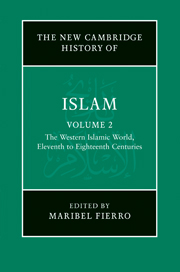Book contents
- Frontmatter
- Introduction
- PART I AL-ANDALUS AND NORTH AND WEST AFRICA (ELEVENTH TO FIFTEENTH CENTURIES)
- 1 Al-Andalus and the Maghrib (from the fifth/eleventh century to the fall of the Almoravids)
- 2 The central lands of North Africa and Sicily, until the beginning of the Almohad period
- 3 The Almohads (524–668/1130–1269) and the Ḥafṣids (627–932/1229–1526)
- 4 The post-Almohad dynasties in al-Andalus and the Maghrib (seventh–ninth/thirteenth–fifteenth centuries)
- 5 West Africa and its early empires
- PART II EGYPT AND SYRIA (ELEVENTH CENTURY UNTIL THE OTTOMAN CONQUEST)
- PART III MUSLIM ANATOLIA AND THE OTTOMAN EMPIRE
- PART IV NORTH AND WEST AFRICA (SIXTEENTH TO EIGHTEENTH CENTURIES)
- PART V RULERS, SOLDIERS, PEASANTS, SCHOLARS AND TRADERS
- Glossary
- Bibliography
- Index
- References
5 - West Africa and its early empires
from PART I - AL-ANDALUS AND NORTH AND WEST AFRICA (ELEVENTH TO FIFTEENTH CENTURIES)
Published online by Cambridge University Press: 28 March 2011
- Frontmatter
- Introduction
- PART I AL-ANDALUS AND NORTH AND WEST AFRICA (ELEVENTH TO FIFTEENTH CENTURIES)
- 1 Al-Andalus and the Maghrib (from the fifth/eleventh century to the fall of the Almoravids)
- 2 The central lands of North Africa and Sicily, until the beginning of the Almohad period
- 3 The Almohads (524–668/1130–1269) and the Ḥafṣids (627–932/1229–1526)
- 4 The post-Almohad dynasties in al-Andalus and the Maghrib (seventh–ninth/thirteenth–fifteenth centuries)
- 5 West Africa and its early empires
- PART II EGYPT AND SYRIA (ELEVENTH CENTURY UNTIL THE OTTOMAN CONQUEST)
- PART III MUSLIM ANATOLIA AND THE OTTOMAN EMPIRE
- PART IV NORTH AND WEST AFRICA (SIXTEENTH TO EIGHTEENTH CENTURIES)
- PART V RULERS, SOLDIERS, PEASANTS, SCHOLARS AND TRADERS
- Glossary
- Bibliography
- Index
- References
Summary
Introduction
The Arab conquest of North Africa was a prelude to a series of developments that reshaped the western part of the ancient world and the way it was viewed. When the general ʿUqba ibn Nāfiʿ al-Fihrī, who was later to become the glorious eponym of numerous Saharan tribes, reached the Atlantic shores (shortly after 63/682), not only had the ‘westernmost’ part, al-Maghrib al-aqṣā, been discovered and included into the Islamic cosmos, but also the expansive energies of the advancing Muslim forces had been diverted to the north and south. Within a few decades the largest part of the Iberian Peninsula, al-Andalus, was incorporated into the territory of the Umayyad caliphate and brought into direct contact with events along the southern Mediterranean coast and in its hinterland. From there, Muslim traders and pious travellers ventured southwards, at first through areas familiar to them from their Arabian background, and then beyond what was regarded as the confines of the inhabitable world. They explored regions where during a long and changeable process a new geographical and cultural segment arose for the Islamic oecumene. Most of these regions had been unknown to the ancient world. But unlike the Romans, who had shielded their provinces of Mauritania and Africa with a wall (limes) from unpredictable Berber tribes roaming the northern Sahara, the Arabs were concerned not with the protection of a civilisation but with the spread of a religion that eo ipso ignored boundaries.
- Type
- Chapter
- Information
- The New Cambridge History of Islam , pp. 144 - 158Publisher: Cambridge University PressPrint publication year: 2010
References
- 1
- Cited by

